#neurological treatment in erode
Explore tagged Tumblr posts
Text

Neurology - care24 Hospital erode
The Best Neurology care in Erode at Care24 Hospital. Trust our expertise for top-quality treatments and compassionate service.
#Neurocardiology consultation Erode#neurological treatment in erode#neurologist in erode trust hospital#neurology doctor near me#Neurology treatment centers#top neurologist care in erode#top neurologist in erode#Top neurology specialists
0 notes
Text
🔥 THE IRREFUTABLE MATH & SCIENCE BEHIND WHY “EQUALITY” IS A FAIRYTALE🔥
WHY MODERN SOCIETY PROMOTES THE OPPOSITE OF “TOLERANCE”

📌 “We just want equality!” screams the movement that thrives on outrage, manufactured victimhood, and eroding meritocracy. 📌 “Feminism is about fairness!” they say—while demanding one-sided benefits, unearned advantages, and special treatment. 📌 “We stand for tolerance!” while canceling, silencing, and demonizing anyone who dares to question their contradictions.
But what happens when you strip away the emotional rhetoric and apply pure, irrefutable logic, math, and science?
🔥 It falls apart instantly. 🔥
Welcome to the cold, mathematical breakdown of why “equality” is a myth and why feminism isn’t about fairness—it’s about control.
And if you can’t handle numbers, logic, and provable reality? 📌 Congratulations. You just earned a spot on the Kamala Soccer Team.
🚀 1️⃣ IRREFUTABLE SCIENCE: MEN & WOMEN ARE NOT “EQUAL” 🚀
Let’s start with basic biological, neurological, and psychological facts.
💀 PHYSICAL DIFFERENCES: IT’S NOT EVEN CLOSE.
✔ Muscle Mass & Strength:
Men have 61% more upper body muscle mass than women. (Source: Journal of Applied Physiology)
Average male grip strength is stronger than 99% of female grip strength. (Source: National Library of Medicine)
Men’s bone density is 30% higher, making them far more resistant to fractures. (Source: American Journal of Physical Anthropology)
✔ Athletic Performance Disparity:
The fastest female sprinter in history (Florence Griffith-Joyner, 10.49s 100m) would be beaten by over 14,000 male athletes today. (Source: Olympic Records & High School Track Data)
The top-ranked female tennis player, Serena Williams, admitted she would struggle to beat the 700th-ranked male player.
📌 The idea of “equality” in physical ability? Mathematically absurd.
🧠 2️⃣ NEUROLOGICAL DIFFERENCES: THE BRAINS AREN’T BUILT THE SAME.
🔹 Men have 10% larger brain volume than women. (Source: Neuroscientific Research, Oxford) 🔹 Men excel in spatial reasoning, complex problem-solving, and pattern recognition. 🔹 Women show stronger verbal skills but score lower in mechanical reasoning and abstract problem-solving. 🔹 Men have a higher tolerance for stress and risk-taking, making them better suited for high-stakes industries. (Source: Psychological Bulletin, APA)
📌 Not worse, not better—just DIFFERENT. The idea that both genders should perform equally in all fields? Mathematically baseless.
📉 3️⃣ THE EQUALITY DELUSION: ACTUAL DATA EXPOSES THE LIE
Feminists push the “oppression” narrative, but the hard data? Says otherwise.
🔹 Workplace Deaths: ✔ 93% of workplace deaths are men. ✔ The most dangerous jobs—logging, construction, military, oil drilling—are overwhelmingly male. (Source: U.S. Bureau of Labor Statistics)
🔹 Family Court & Custody: ✔ Men lose custody battles 85% of the time. ✔ Women initiate 70% of divorces, but still walk away with assets and child support. (Source: National Center for Family & Marriage Research)
🔹 Criminal Sentencing Disparity: ✔ Women receive 63% lighter sentences for the exact same crimes as men. ✔ Men are far more likely to be falsely accused of crimes without evidence. (Source: U.S. Sentencing Commission)
📌 Feminists scream about “oppression” but ignore all the areas where they hold privilege.
🤡 4️⃣ MODERN FEMINISM = ANYTHING BUT “TOLERANCE”
For a movement that claims to be about “equality” and “acceptance,” feminism today:
❌ Silences anyone who disagrees. ❌ Cancels men for opinions they don’t like. ❌ Demonizes masculinity while demanding the benefits of it. ❌ Crushes meritocracy by forcing quotas instead of earning positions.
✔ They claim they want “strong men” but shame men who exhibit strength. ✔ They claim they want “equality” but demand special treatment. ✔ They claim they want “respect” but refuse to be held to the same standards as men.
📌 It’s not about tolerance—it’s about CONTROL.
🛑 FINAL VERDICT: EQUALITY IS A MYTH—MATH & SCIENCE PROVE IT.
Men and women are not interchangeable. Biology, neurology, and psychology prove this without a doubt. Feminism? It has devolved into a movement of control, entitlement, and special privileges—not actual fairness.
If you reject math, science, and facts? 💀 You belong on the Kamala Soccer Team.
🚀 REBLOG if you’re tired of fabricated narratives. 🔥 FOLLOW if you know real tolerance comes from truth, not censorship. 💀 LIKE if you support facts over feelings. 💬 COMMENT if you’ve ever seen “equality” crumble the second reality hits.
#writing#writers on tumblr#dark academia#horror writing#creepy stories#weird fiction#writing community#yeah what the fuck#funny post#funny stuff#lol#funny memes#funny shit#memes#humor#jokes#funny#tiktok#instagram#youtube#youtumblr
5 notes
·
View notes
Text
Kottakkal Arya Vaidya Sala in Erode is an authorized dealer of the renowned Ayurvedic institution, Arya Vaidya Sala, headquartered in Kottakkal, Kerala. Established in 1902 by Vaidyaratnam P. S. Varier, Arya Vaidya Sala has been a pioneer in Ayurvedic healthcare, offering authentic treatments and therapies rooted in ancient Indian wisdom. citeturn0search0 The Erode branch provides a range of services, including Panchakarma treatments, skin problem solutions, Ayurvedic consultations, neurological disorder management, spine and joint pain relief, and lifestyle disorder treatments. Their holistic approach emphasizes preventive care and natural healing, ensuring personalized treatment plans tailored to individual needs. With a team of qualified practitioners and genuine Ayurvedic products sourced directly from Kottakkal, patients can experience comprehensive wellness solutions. For appointments or more information, visit their website or contact them at 9442881005.
TO know more: https://kottakkalerode.com/
0 notes
Text
A change of pace, or, perhaps, place…
Nothing revelatory, as is usual for these “under-the-cut” posts but it seems this space is the only one where I can share such thoughts without anxiety, for whatever reason.
It has been a bit over one month since I have started medication as part of my treatment for the persistent depressive symptoms which have been plaguing me for the greater part of seven years, and that duration is merely a culmination of roughly two decades of what I might refer to as, “melancholia.”
As you, Dear Reader, must surely have gleaned if you have followed this blog at any length, is that my general attitude toward life is situated upon a downward-facing angle, for want of a better suggestional image—this attitude has been with me for so long that I have acclimated to it’s atmosphere, the sights and sounds, and thereby have made something of a life accommodating what—I have only recently realized—is not something others necessarily experience. I do not know which examples to share, if any, and so my thought is muddled at present, and suffice it to say my metaphorical cloud, were it to dissipate, would leave me feeling all-too vulnerable and unmoored, or so I believe.
Thought of disposing of myself has been a lingering (and lurking) one since I’ve been about ten years old. Disturbingly young but the fact remains. Just over two decades of cohabiting with this mental spectre means I have made room for it in my life, an unwelcome yet not unfamiliar guest, sometimes in my company sometimes residing within a further chamber… in making such accommodation, I know which creaking boards (metaphorically speaking) to avoid that might disturb this spectre, and I can usually detect behind which door it resides and—through mental and emotional work—I can also bypass agitating it.
But you see, Dear Reader, my emotional and mental acuity have waned in recent years. My patience and hope have both been worn threadbare. Whatever focus I have control over I turn it upon the most immediate task or thing before me, or at least try. There is no thought of future plans or goals. To schedule a date for anything is reserved for medical appointments only. Not necessarily my own…. I fear complaining too much and too often about such things… back to my point: the spectre has grown in strength that I can scarce keep it contained when it becomes enraged. The more appropriate analogy may be that my own strength and resolve have eroded to such extant that renders me unable at times to control the thing. This state of helplessness is what prompted me to seek help in earnest last year.
In some ways it seems far too late for any help. In other ways it appears not at all helpful, and the current medication regimen may not be the most appropriate for my particular problem. Whatever the case, I’m navigating these uncharted waters with trepidation. I’ll spare details for now, but the overall affect is an amalgamation of isolation, loneliness, regret, sadness, and anger.
In other news, I was treated to a dream last night, the memory of which clings to me like a tenuous thread of hope, not something within my grasp but instead, it somehow has drifted onto me, as one might find the remains of a dewy spider web upon one’s clothing after walking in the forest—the beauty torn, evidence of what was only moments before now rent into ragged strands.
The personage that made me feel welcome and as though my “old self” had returned was merely an illusion, a trick of synapses and neurological activity, stimulated into appearing as real as any person in front of me. My phantom friend dissolved into the ether upon my waking, but I was fortunate enough to somehow feel the remains of imaginary touch upon me, and this was a balm of sorts, soothing the inevitable sting of a new day and returned consciousness to the physical world.
Will this benevolent phantom ever visit again? Who may tell… bittersweet indeed, as the perfume of dream fades, and I am once more within the ungentle embrace of reality.
Until next time, Reader.
Take good care, and be well—M
#a curious mess of stream-of-consciousness#I have not set my editorial eye upon this entry#so here it stands as an update of sorts
2 notes
·
View notes
Text
Bullous Pemphigoid: An Autoimmune Skin Disorder Affecting Elderly Population
What is BP?
BP is a chronic, autoimmune, blistering disease of the skin that affects the elderly population predominantly. It causes the formation of large, fluid-filled blisters on areas of skin that appear normal at first but upon blistering can cause immense discomfort and pain. The blisters usually form on the skin surface, just above the basement membrane. Causes and Risk Factors
InBullous pemphigoid, the immune system mistakenly attacks proteins in the basement membrane of the skin called BP180 and BP230. This results in inflammation and antibody creation against these proteins. When antibodies attach to these proteins under the skin surface, it causes the skin layer above to separate from the deeper skin layer leading to blister formation. While the exact cause of BP is unknown, certain factors increase the risk of developing this disease like advanced age (over 60 years), family history of autoimmune disorders and physical trauma or injury to the skin. Other potential causes under investigation include genetic predisposition, medications and underlying medical conditions like cancer, neurological disorders and infectious agents. Elderly adults above 80 years have the highest prevalence rate of BP.
Signs and Symptoms
The most common initial symptoms of bullous pemphigoid include red, itchy patches or blisters on the skin which may appear on parts of the body like abdomen, thighs, arms or trunk. The blisters range from half a centimeter to several centimeters in diameter and appear in groups or clusters. As the blisters rupture, they leave behind painful, shallow erosions or raw areas. There may also be associated symptoms like burning sensation or pain at the affected sites. Diagnosis To diagnose BP, the doctor examines the lesions and takes a skin biopsy to view the area under the microscope. The diagnostic hallmarks are presence of inflammation around blood vessels in the upper dermis and separation between the epidermis and dermis layers. Immunological tests are often done to detect high levels of BP180 and BP230 antibodies in blood which supports the diagnosis. Other skin conditions with similar appearance like dermatitis herpetiformis are ruled out through testing.
Treatment
Conventionally, BP is treated with oral corticosteroids like prednisone as the first line therapy to suppress the immune system and stop blister formation. Topical corticosteroid creams are also prescribed for localized involvement. Other immunosuppressants like azathioprine or mycophenolate mofetil may be used in cases where high dose steroids cannot be gradually tapered off. Anti-inflammatory drugs like dapsone or tetracyclines also provide relief in mild cases. Laser therapy and corticosteroid injections directly in blisters helps treat localized areas. Proper wound care to prevent infections in eroded areas along with topical antiseptics, antibiotics and dressing is important.
Prognosis With appropriate long-term treatment, the outlook for patients with bullous pemphigoid is generally good. The disease activity declines gradually over several months to years in most cases until it is well controlled. However, complete remission is rare and flare-ups can occur due to varying severity. With immunosuppressive drugs, the risk of life-threatening infections also increases, needing close medical monitoring. Refractory cases unresponsive to conventional therapy carry poorer prognosis. Proper diligent management of nutritional and hydration status in elderly patients helps speedy recovery.
Impact on Business
BP predominantly affects the geriatric population above 60 years. As populations across the world continue to age at an accelerated rate, the prevalence of this autoimmune blistering disease is expected to rise proportionately in the coming decades. This posses significant economic and social burden both for affected families and healthcare systems. The direct treatment costs related to medications, wound care products, long term follow up visits and potential hospitalizations add up substantially over the chronic course of the disease. From a pharmaceutical business perspective, bullous pemphigoid represents a growing therapeutic area and market opportunity. With advancements in immunology and targeted therapies, newer treatment options are being explored besides conventional steroids. Biologic agents modulating specific pathogenic immune pathways show promise. Skin care product companies can capitalize on increasing demands for special dressings, ointments, antiseptics and moisturizers catered for BP patients. Healthcare service providers will require to boost capacity and expertise in geriatric dermatology management to handle rising caseloads. Overall, BP highlights ageing as a critical risk factor businesses must reckon with from multiple angles. Proactive preparedness to face future implications of this condition can provide both opportunities and advantages.
Get more insights on this topic: https://www.newsanalyticspro.com/understanding-the-rare-autoimmune-skin-condition-called-bullous-pemphigoid/
About Author:
Ravina Pandya, Content Writer, has a strong foothold in the market research industry. She specializes in writing well-researched articles from different industries, including food and beverages, information and technology, healthcare, chemical and materials, etc. (https://www.linkedin.com/in/ravina-pandya-1a3984191)
*Note: 1. Source: Coherent Market Insights, Public sources, Desk research 2. We have leveraged AI tools to mine information and compile it
#Bullous Pemphigoid Trend#Bullous Pemphigoid Size#Bullous Pemphigoid Information#Bullous Pemphigoid Analysis#Bullous Pemphigoid Demand
0 notes
Text
ASPERGILLOSIS IN DOGS
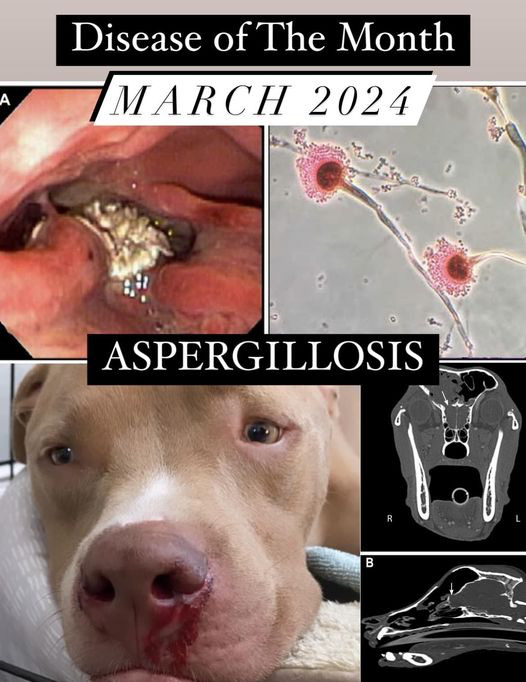
Aspergillosis is a fungal infection caused by a type of mold called Aspergillus. There are over 200 known species of Aspergillus fungi found worldwide that can grow either indoors or outdoors, and are commonly found in soil, dead or decaying vegetation, or spoiled food. They produce tiny asexual spores that can be easily inhaled or ingested, although do not generally lead to disease in humans or animals, unless the host has a compromised immune system or has significant exposure to the fungus.

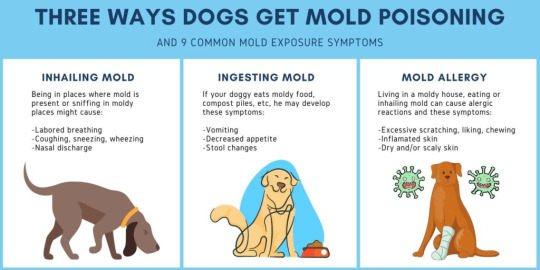
SINONASAL ASPERGILLOSIS
In dogs, especially dolicocephalic (long-snout) breeds such as the Greyhound, Collie, and Dachshund, aspergillosis is typically localized to the nasal cavity/sinuses. Symptoms of sinonasal aspergillosis include chronic sneezing and bloody nasal discharge, classically from one nostril, and sometimes depigmentation and/or ulceration of the nares.
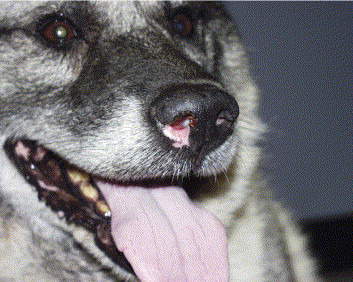
Mucous will eventually build up into a "fungal ball", or aspillergoma, which can be detected under advanced imaging.
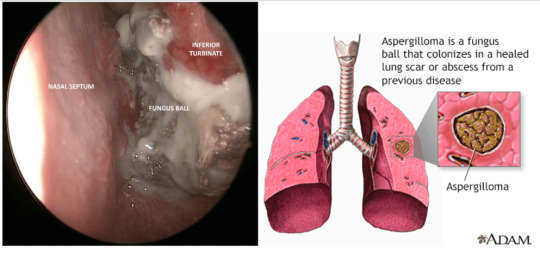

In severe cases, there will be marked damage of the nasal turbinates and the infection spreads from within the sinus cavity through the frontal bone of the skull, invading into the brain and central nervous system. For this reason, CT scan is highly recommended along with a rhinoscopy.
youtube
Historically, treating fungal infections with oral medications are very challenging, as the infections are often very slow to clear, and many anti-fungals available on the market are not only expensive, but may have severe side effects including liver damage and neurological symptoms. Because of this, the debridement of fungal lesions followed by topical infusion have become the gold standard treatment, as long as the cribriform plate of the skull is intact.
youtube
While under anesthesia, fungal plaque is removed with the guidance of a scope in the nasal cavity. In some cases, however, fungal plaque may be located in the sinuses but not in the nasal cavity - in which case trephination may be performed. An incision is made along the forehead to remove a layer of bone to create access.


Once the aspergilloma is debrided, a clotrimazole (anti-fungal) solution is infused into the nose and frontal sinuses while the the back of the patient's throat is closed off with gauze and foley catheters. (The patient is able to breathe through an endotracheal tube.) Cotton swabs are used to plug the nostrils, and the clovtrimazole solution incubates for 30 minutes to 1 hour, as the patient is periodically rotated to allow even distribution throughout the sinuses and maximize penetration.



The clotrimazole solution is then drained out the nostrils and suctioned out. While this treatment has been shown to be highly effective, about 1/3 of patients may need repeat infusions.
If there is evidence that the infection has already eroded through the sinus bones and penetrated the brain, then the treatment described above may not be used, and oral medication would be recommended instead. Several months of treatment would be required, with a reported 60-70% success rate, compared to 86% observed in fungicide infusions.
DISSEMINATED ASPERGILLOSIS
Systemic aspergillosis occurs in dogs when the fungal spores diffuse past the respiratory system and enter the bloodstream, spreading to other sites within the body, including bone, spine, muscles, kidneys, as well as the eyes. A bronchopulmonary form of aspergillosis also forms in dogs, although rare.



Although less commonly diagnosed, disseminated aspergillosis is most often observed in young-middle aged female German Shepherds and most commonly associated with the A. terreus species. Many patients may also have underlying immunocompromise, such as diabetes mellitus or concurrent bacterial infections, or are receiving immunosuppressive medications, such as glucocorticoids or chemotherapeutics.
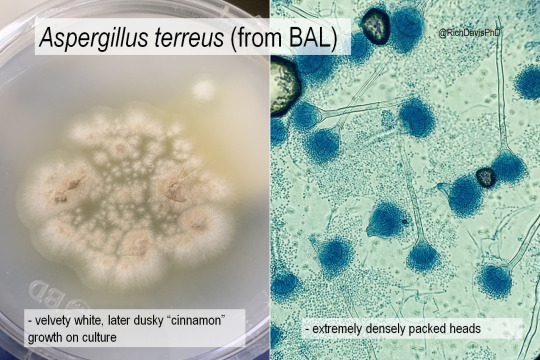
Clinical signs of disseminated aspergillosis are dependent on which organ(s) are involved, although many dogs may also show nonspecific signs such as anorexia, lethargy, and fever. Other symptoms of systemic involvement include weight loss, muscle wasting, hematuria, urinary incontinence, uveitis, and neurological deficits such as head tilt and ataxia. There are also often draining tracts (holes with pus or bloody discharge oozing out) in areas of infection.

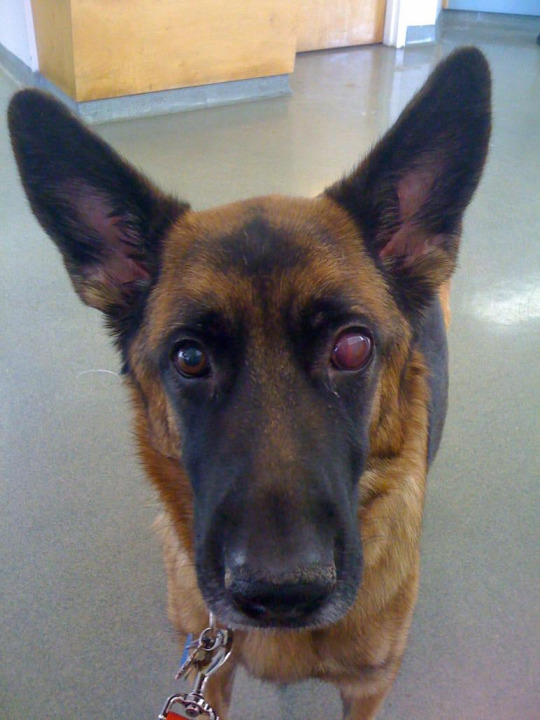
Diagnosing disseminated aspergillosis can actually be quite difficult and invasive. Unfortunately, many dogs are often terminal by the time aspergillosis is suspected, and have an extensive history of failed antimicrobial treatment before diagnosis.
Treatment is also particularly frustrating for these cases, either requiring years - or even lifelong - administration of anti-fungal drugs, and regular follow-ups to monitor for any side effects. While some anti-fungals like iconazole and fluconazole are more cost-effective than others, they are not as effective clinically. On the other hand, the ones that are more effective, like voriconazole, are also more expensive and more toxic over time.

Often times, surgery may also be required to remove the source of the fungal infection (i.e. limb amputation, osteotomy, lung lobectomy, enucleation, etc.). Although surgery may sometimes be curative, prognosis is generally very guarded to poor, as many dogs will often die of their disease before medication can begin to control their condition, or if the surgery required is out of reach.
However, treatment should still be considered in dogs with less severe clinical signs. While treatment of an opportunistic fungal infection is very challenging, early recognition and aggressive treatment can enhance the chance for success.


Sources/Further Reading:
Ballber, Clara, et al. “Minimally invasive treatment of sino‐nasal aspergillosis in dogs.” Journal of Veterinary Internal Medicine, vol. 32, no. 6, 16 Oct. 2018, pp. 2069–2073, https://doi.org/10.1111/jvim.15311.
Bennett, Peter F., et al. “Long term survival of a dog with disseminated Aspergillus deflectus infection without definitive treatment.” Medical Mycology Case Reports, vol. 22, Dec. 2018, pp. 1–3, https://doi.org/10.1016/j.mmcr.2018.07.002.
Brooks, Wendy. “Aspergillosis in Dogs.” Veterinary Partner, VIN (Veterinary Information Network), 1 Nov. 2023, veterinarypartner.vin.com/default.aspx?pid=19239&id=4952634.
Gull, Tamara. “Aspergillosis in Animals.” Merck Veterinary Manual, Merck & Co., Inc., Apr. 2023, www.merckvetmanual.com/generalized-conditions/fungal-infections/aspergillosis-in-animals.
Nelson, Whitney, and Audrey K. Cook. “When to Consider Aspergillosis in Dogs.” DVM 360, MJH Life Sciences, 1 Aug. 2010, www.dvm360.com/view/when-consider-aspergillosis-dogs.
Pascutti, Kristina, and Stuart A. Walton. “Approaches to Opportunistic Fungal Infections in Small Animals.” Today’s Veterinary Practice, 7 Apr. 2021, https://todaysveterinarypractice.com/internal-medicine/approaches-to-opportunistic-fungal-infections-in-small-animals/.
Renchler, J.S. “A Review of Systemic Aspergillosis in Dogs.” Clinical Reviews, Mira Vista Veterinary Diagnostics, Oct. 2020, miravistavets.com/fungal-diseases/aspergillus/review-systemic-aspergillosis-in-dogs/.
#aspergillosis#canine health#veterinary medicine#small animal internal medicine#fungal infection#sinonasal aspergillosis#disseminated aspergillosis#canine disease#dogs
1 note
·
View note
Text
Kottakkal Arya Vaidya Sala Erode is the leadingKottakkal ayurveda in Erode, Tamil Nadu was established in 1960. Our doctor, Dr. Balakrishnan MD (AYU), is a specialist in all panchakarma treatments, Kerala special therapies, and surgical procedures in Ayurveda. Kottakkal Arya Vaidya Sala Erode is one of the best ayurvedic hospital in Erode, providing all kinds of treatments. especially knee joint pain, low back ache, neck pain, shoulder pain, and skin problems such as psoriasis, urticaria, and dermatitis. Neurological disorders such as stroke, weakness of the lower limb, facial palsy, and general problems such as sleeplessness, stress, and Kottakkal Authorised Dealer in Erode all kinds of Ayurvedic medicine.

Kottakkal Arya Vaidya Sala Erode Phone: +91 88700 65333 Address: 951, Brough Road, Erode, Tamil Nadu 638001 Location: https://goo.gl/maps/GftNdSEfoeHmsiFt9 Website: https://kottakkalaryavaidyasalaerode.com/ Website: https://aryavaidyasalaerode.com/ Orginal Kottakkal Arya Vaidya Sala Erode: aryavaidyasalaerode.com
Connect with Kottakkal Arya Vaidya Sala Erode https://www.facebook.com/kottakkalaryavaidyasalaerode/ https://www.instagram.com/kottakkalaryavaidyasalaerode/ https://twitter.com/kottakkalerode
#KottakkalAryaVaidyaSalaErode #KottakkalAryaVaidyaSala #KottakkalErode #AyurvedicClinicErode #KottakkalAuthorisedDealer #AryaVaidyaSalaErode #ErodeKottakkal #KottakkalAVS #Ayurveda #Medicine #HouseOfAuthenticAyurveda #traditionalayurveda #kottakkalayurveda #Kottakkal #AyurvedicClinicErode #KottakkalAyurvedicClinic #KottakkalErode #KottakkalAyurvedicClinicErode #AyurvedicHospitalErode #KottakkalTreatmentCenter
#ayurveda#ayurvedicclinicerode#KottakkalAryaVaidyaSalaErode#KottakkalAryaVaidyaSala#KottakkalErode#AyurvedicClinicErode#KottakkalAuthorisedDealer#AryaVaidyaSalaErode#ErodeKottakkal#KottakkalAVS#Ayurveda#Medicine#HouseOfAuthenticAyurveda#traditionalayurveda#kottakkalayurveda#Kottakkal#KottakkalAyurvedicClinic#KottakkalAyurvedicClinicErode#AyurvedicHospitalErode#KottakkalTreatmentCenter
0 notes
Text
Ya know the whole, V's supposedly has very little time left and is dying quickly, but has like all this time to fuck around cause the game only remembers V is dying when the main plot hits other than the occasional relic malfunction.
My absolute bullshit justification for this with my V is that she was already on immunosuppressants pre-Johnny, because she has an autoimmune disease. Because it seems to me like the relic is written like a very aggressive neurological autoimmune disease. Like it's making the body turn on itself and rejecting all the things that make V, destroying the brain tissue. I think part of a line is that at a certain point V's body rejects V, it doesn't recgonize V and treats them like a cancer that needs to be fixed. Like antibodies over acting and attacking healthy tissue in an autoimmune disease.
So, obviously it's much more advanced and aggressive than a regular autoimmune disease, because it's advance tech and rewiring her brain to be Johnny's. So, it doesn't stop it, but I think it could theoretically slow down the process. Like how people were theorizing that the MS neural nanite treatments could help V, since it's V's neural tissue that is eroding. MS is an autoimmune disease and the way to treat it currently, in a world where those fancy nanites are far away, immunosuppressants. Which would still A) still be available i assume and B) even more beefed up even if they're not as impactful as the super treatments.
Now obviously, this isn't like solid science, I ain't no doctor and cyberpunk acts on it's own uhhhh logic. But idk, i think it could slow down this stuff.
Basically, my V's body has been attacking itself and trying to kill her long before Johnny was ever a thing in her life, so she's kinda use to this shit (on a lower scale).
6 notes
·
View notes
Text
Top Neurology Care in Erode – Expert Treatment and Consultation
For those seeking specialized neurological care, finding the right hospital and specialist is essential. If you're looking for Neurocardiology consultation in Erode, expert neurologists at leading hospitals provide advanced care for brain and heart-related neurological disorders.
Comprehensive Neurological Treatment in Erode
Erode is home to several Neurology treatment centers that offer world-class care for conditions like stroke, epilepsy, multiple sclerosis, and Parkinson’s disease. Whether you're searching for neurological treatment in Erode or need ongoing therapy for chronic neurological disorders, top hospitals in the city provide personalized and evidence-based treatment plans.
Trusted Neurologists in Erode
If you're looking for a neurologist in Erode Trust Hospital, you can find highly qualified specialists who are experienced in diagnosing and treating various neurological conditions. These experts ensure accurate diagnoses and effective treatments tailored to each patient's unique needs.
Finding the Best Neurology Doctor Near You
For those looking for a neurology doctor near me, Erode has some of the best specialists offering both inpatient and outpatient services. From routine consultations to complex neurosurgeries, top hospitals are well-equipped with cutting-edge technology to provide advanced care.
Advanced Neurology Treatment Centers
Neurology treatment centers in Erode offer specialized services, including:
Stroke rehabilitation and emergency care
Epilepsy diagnosis and management
Movement disorder treatment (Parkinson’s, dystonia, etc.)
Neurocardiology consultation for heart-brain health
Minimally invasive neurosurgeries
Top Neurologists and Specialists in Erode
For those seeking top neurologist care in Erode, leading hospitals provide expert consultation and comprehensive treatment. If you're searching for the top neurologist in Erode, rest assured that the city has renowned specialists dedicated to neurological wellness.
Why Choose the Best Neurology Specialists?
When it comes to neurological health, selecting the top neurology specialists ensures accurate diagnosis, effective treatment, and compassionate care. Erode’s leading hospitals are equipped with state-of-the-art technology and expert teams to handle even the most complex cases.
For anyone in need of neurological care, finding the right expert is crucial. Whether you require a neurology doctor near me or specialized Neurocardiology consultation in Erode, the city's top hospitals are dedicated to providing exceptional care and improving patient outcomes.
#Neurocardiology consultation Erode#neurological treatment in erode#neurologist in erode trust hospital#neurology doctor near me#Neurology treatment centers#top neurologist care in erode#top neurologist in erode#Top neurology specialists
0 notes
Text
something that does disturb me about some of these corona virus self-reports, is a small account given by those that have had corona virus or know someone who went through corona virus. Third-party reports, with minimal credibility, but there is a disturbing narrative I review, that comes from a common attribute. There is a dismissive often casualness to these reports, which comes from someone who has done minimal research into the significance.
A somewhat frequent trend is that those young people, who have the minimum side-effects (such was mild aches and soreness in the throat, sometimes headaches) go on to ‘recover’ from corona virus. Then go on to say, “Taste or the sense of smell has not returned. At all.”
To the “it’s just a flu” crowd, this is dismissed as typical allergy or side effects of a mediocre cold. But the account may have a more unsettling significance.
I have a family member, who several years prior, suffered a very mild stroke. A mild stroke can be missed, because it does not have outward significance to those who knew the individual. And, we only put together the context of this stroke and it’s impact on her health, years later, when she displayed early onset dementia. The stroke was only made knowledge years following, after a MRI scan revealed the mild onset of neuro damage that matches to a stroke pattern, though it was not outwardly visible. Though this family member, aware that her mind was damaged but not comprehending how, made the efforts to square away essential assets and put her future care in order. There is more to this story, but it is personal and not relevant to the corona virus tangent I am going through.
Now, of this early onset dementia, our first clue was that her sense of smell and taste was affected. Bear in mind, no neurological discrepancies were visibly apparent at the time - and this medical narrative comes before a time when resources for dementia or Alzheimer's was made readily available. The plot we built around our ailing individual, we had to piece together years later following the discovery of medical documents. However prior to the documents surface, as years endured, it became more apparent that memory loss was setting in, and she was aware of this.
What does this have to do with corona virus? From what we have gathered with the virus, is that it is systemic, it can infect and damage other organs and tissue of the body. It can infect the brain and optical nerves, it can affect the liver and kidneys. There is a distinct difference between pneumonia corona virus and the systemic corona virus - these health issues are one in the same - though it only establishes where corona virus has infiltrated and damaged. It is only when corona virus has infiltrated the lung tissue and presents itself in respiratory distress, that people think that they have contracted corona virus. And I tell my family this, when they have a little throat thrash - Corona virus WILL NOT present itself first as a cold or abrasive throat. You will not know you have it, and when you begin presenting the common and true respiratory distress, it may be too late.
And right here I want to make a very crucial note. Ebola first presents as a flu or cold. Meningitis first presents itself as a flu or cold. Measles first presents itself as a cold or flu. Invasive fungal sinusitis first presents itself as a flu or cold. A deadly bacteria microbial that killed a 6 year old in Texas, first presented itself as a cold or flu, or corona virus.
What all these illnesses have in common, is that, they present firstly as a common cold or flu, but if the medical institute which treats the infected fails to work fast enough to actually diagnose the individual, they will die. Yes. Ebola is fatal to many people without hospital intervention and antiviral treatments, and even still if it is not controlled quick enough the infected person will perish. Measles is deadly to children AND adults. Invasive fungal sinusitis is often fatal, unless the contaminated tissue is hacked out of the persons face - this usually results in disfigurement. The point being, because something has been described as a little flu or cold, does not mean it is harmless - it only means that we can see these symptoms presented. It is a prescript response the body has, to many viral or bacterial infections, due to an inflamed reaction to compromised tissue. That is what a sore throat is, tissue contaminated to invasive cells which the bodies white blood cells must destroy and remove - this results in abrasion or a ‘burn’. When you want to refurbish furniture, you first must remove tarnished and unsightly top coat through sanding. You can accidentally disfigure your furniture project if you are not careful, or need to do repairs on weaknesses or damage inflicted by age. The body is the same way, the cells destroy the infected cells and some cells which are not infected - this is the cytokine storm which puts individual infected with covid, into the hospital for essential medical intervention.
Now back to this topic of dementia and neuro damage. These young people as reported casually, having recovered a ‘mild’ infection from covid, and did not present any symptoms or barely ‘noticed’ any aches or whatever. They still report a loss of taste and smell. Why this is concerning to me, is it can mean that covid cells infiltrated the brain and got up to some not good businesses. NOW, I am NOT here to say, “omg, these people are doomed. Oh no.” What I will say, is that they ARE NOT CURED.
The body likely responded to some sort of infection, it might have only affected the sinus cells. Whether or not antibodies were produced is unknown. There is a possibility that the headache is a result of the body attacking compromised cells in the brain, and if that sounds scary, DO NOT LET IT MAKE YOU AFRAID. This is very important. This is only a cautionary segment, and a plea for those who have suspected they may have been exposed to covid, or have recovered from covid, to be cautious from here on out. Neuro cells can rebuild themselves, to a degree. Neuro cells or brain cells, are notorious for being permanent, non-replicable. But they can be fixed by small increments. It can also take months, or years, in an individual that is healthy. This is why I say those who have lost some sensory, must absolutely be careful. Covid cells have a very direct plan of attack, they are very illusive in the body, and cells that have gone through the trauma of protecting you from this virus may be weakened to some degree.
This is why I am adamant about directing focus to the lack of immunity or the relapses when they occur, to those that previously thought they recovered from covid. I saw a beautiful post on here a few days prior, about a woman who is HIV +, but is able to have children and a husband, without fear for them contracting the virus, because she has medicine to keep the viral count down. Thus, her family does not need to worry about HIV, her children can live a normal life, and she can have children. It’s a blessing.
It is also a very important narrative for the corona virus, an illness we are still struggling to understand to the full of our capacity. This speculation I have that antibodies formed following a corona virus infection, may be short lived or unreliable to future infection. If a person is subjected to a high concentration of virus load, such as our healthcare workers, the prospect of infection and a lethal infection increases. This is why metropolitan areas need harsh restrictions due to the corona virus, the high concentration of people increases the infection rate - probability - of a positive infection. The more covid cells you encounter, the higher risk and possibly the more severe your infection because your body is not capable of keeping up with the infection onslaught. Healthcare workers MUST BE EXTREMELY CAUTIOUS - that is why they wear hazmat suits while treating covid sufferers. They are in a viral load element, and many can not go home to their families because the risks are too great.
If you suspect you have had covid or may have encountered someone with covid, reduce your interaction with people. Do not go out. Treat yourself like you are still struggling with the virus, even if you feel you are not. Behave like you are still taking the medication your doctor gave you, even though you feel better. Let your body do its job to its fullest, before you go out courting covid once more. If you keep subjecting your body to a trauma, then the cells become eroded and run down - it increases the probability of a severe infection which will have ultimate consequences.
“Young people seem to bounce back” is a highly irresponsible narrative. We do not grasp the full effects of corona virus infection in young people. We have no test group, nor a control group. But we can follow patterns. The cases increase, due to the false belief that corona virus is not serious. It likely comes from some young person believing, “I recovered and didn’t feel that bad, thus, the virus is not that bad. I am very healthy, and the virus didn’t stand a chance.”
Wherein the truth is, your body managed to get the virus under control to the point the young person felt good. And yes, because the young person may be healthy, but they are not exempted from a second, or third infection. IF THE ANTIBODIES ARE NOT THERE. This is where we reach the relapse, reinfection, and the ongoing lethargy that some people endure. The virus is still present, but it is managed by the body. The body is producing antibodies, but the virus is still producing cells which attack the body.
This may also explain the “negatives” of those that test negative, but still feel like crud. The negative of a covid test, might mean that there is not sufficient viral load to reach a positive result. I could be wrong. All I have right now are speculation, theories. But the doctors are telling us fundamental things, and not going into specifics why.
You do not want to contract corona virus. It does not care how healthy you are, it’s primary mission is replicate and spread, and feed on hemoglobin.
When people say, “Yeah, I still don’t have my sense of taste and or smell back.” I am very alarmed. Because when someone dismisses something so essential, my first concern is not, “That is common in colds”; I begin thinking, “This virus attacks any tissue, and the sinuses have been traumatized. How long does this last?”
We do not know enough about this virus to be complacent. It does not behave anything like a cold or flu, aside from symptoms which are a synonymous onset to every other kind of horrendous viral or bacterial infection with a high fatality rate. The cytokine storm is a very sudden, aggressive onslaught on anything compromised by corona virus cells - including cells that may have not been infected let alone compromised. Individuals who come across as very proud to have recovered so efficiently from a possible corona virus infection, may be health compromised or primed for a second more serious infection.
And last, if you are a person who does not know where you liver is located, then you probably shouldn’t conclude you’ve recovered from the corona virus. And final, if you lost your sense of taste or smell, you need to be more cautious from here on out because it is possible you are not fully recovered.
#corona virus#coronavirus#covid19#covid#covid 19#covid-19#wear a fucking mask#wash your hands#watch your distance#viral behavior#rona#corona#beer#i feel like Im talking to a brick wall that believes it is a fluffy fog bank#you are not a fluffy fog bank youre a fucking brick wall#there is no way in hell i will try driving through you only an idiot would do that
1 note
·
View note
Text
E.P.A. to Roll Back Rules on Coal Toxins https://nyti.ms/331lHoE
THIS DEREGULATION BENEFITS NO ONE BUT POLLUTERS LIKE DUKE ENERGY WHO HAVE POLLUTED rivers and streams in Georgia, North Carolina, Pennsylvania, Tennessee and Virginia. Trump ISN'T interested in MAGA, he just wants to MASA( MAKE AMERICA 🇺🇸 SICK AGAIN). SHAME. SHAME. SHAME.
"More than 100 million tons of coal ash is produced every year, one of the nation’s largest and most vexing streams of toxic waste. The hazardous dust and sludge — containing arsenic, mercury, lead and other heavy metals — fill more than a thousand landfills and bodies of water in nearly every state, threatening air, land, water and human health."
"Support for protecting water supplies from coal ash contamination cut across party lines and that efforts by the Trump administration to curb enforcement would be opposed even by residents who had voted for the president."
🎃☠️🎃☠️🎃☠️🎃☠️🎃
E.P.A. to Roll Back Rules on Coal Toxins
By Lisa FRIEDMAN | Published October 31, 2019, 9:23 AM ET | New York Times | Posted October 31, 2019 |
WASHINGTON — The Trump administration is expected today to roll back an Obama-era regulation that was to limit emissions of heavy metals like arsenic, lead, mercury and other toxins from coal-fired power plants, according to two people familiar with the plans.
In a rule expected as early as Thursday, the Environmental Protection Agency will move to weaken the 2015 regulation by relaxing some of the requirements on power generators and also exempting a significant number of power plants from even those requirements.
The effort was designed to extend the life of old, coal-fired power plants that have been shutting down in the face of competition from cheaper natural gas and renewable energy generators. Environmental groups warned that the move could lead to health problems caused by contaminated drinking water, including birth defects, cancer and stunted brain development in young children.
A spokesman for the E.P.A. did not immediately respond to a request for comment.
Coal ash is the residue produced from burning coal. Power plants produce about 130 million tons of coal ash a year, which is stored at about 1,100 sites across the country.
Spills in Tennessee and North Carolina leaked toxic materials into rivers over the past decade.
According to the E.P.A., about 1.1 million Americans live within three miles of a coal plant that discharges pollutants into a public waterway. The 2015 rule set deadlines for power plants to invest in modern wastewater treatment technology to keep toxic pollution out of local waterways. The Obama administration estimated the regulations would stop about 1.4 billion pounds of toxic metals and other pollutants from pouring into rivers and streams.
But the rule would also raise the cost of operating the plants, further endangering their economic viability.
One person familiar with the E.P.A.’s current plans said the agency intends to say that the new rule will remove more pollutants than the Obama-era regulation. That argument is based on an analysis that assumes about 30 percent of power plants will voluntarily chose to install more stringent technology.
Power plants were originally required to start complying with the requirements by as early as November 2018, but Scott Pruitt, President Trump’s first E.P.A. administrator, postponed compliance until 2020, saying the agency was providing “relief” to utilities as it reviewed the rule.
Environmental groups have challenged that delay and said they would also challenge the rollback.
A recent study by environmental groups found that more than 90 percent of the 265 coal plants required to test their groundwater near coal ash dumps discovered unsafe levels of at least one contaminant.
“That knowledge should lead E.P.A. to move to establish greater protections for our health,” said Lisa Evans, a senior counsel for Earthjustice, an environmental organization. “But E.P.A. is running the other way under the direction of the utilities.”
🎃☠️🎃☠️🎃☠️🎃☠️🎃
What Is Coal Ash and Why Is It Dangerous?
By Christopher Mele | Published Sept. 21, 2018 | New York Times | Posted October 31, 2019 |
The phrase “coal ash” made headlines this week after a dam on a lake at the site of a power plant in Wilmington, N.C., was breached, allowing the hazardous ash into a river that supplies drinking water to much of the southeastern part of the state.
The plant that was shut down, owned by Duke Energy, had been a growing concern since last week after heavy rains associated with Hurricane Florence caused a coal ash landfill at the site to erode, spilling ash onto a roadway.
What is coal ash?
Coal ash is the powdery substance that remains after burning coal.
What remains after coal is burned includes fly ash, bottom ash and so-called scrubber sludge, said Lisa Evans, chief counsel to Earthjustice, an environmental law organization.
The sludge, which is created from solutions sprayed inside exhaust stacks to capture the harmful chemicals that cause acid rain, sulfur dioxide and nitrogen oxide, falls to the bottom.
All of those remnants are mixed with water and then sent to vast retaining ponds or impoundments near the coal-burning power plants. An estimated 110 million tons of coal ash is produced each year, Ms. Evans said.
Why is it hazardous?
The remnants of burned coal include arsenic, boron, lead and mercury, which are known carcinogens and damage organs, among other health effects.
Is the ash really held in ponds?
No, according to Ms. Evans. That is the colloquial description of these basins, but it is really a misnomer given their size, she said.
“It’s a hard thing to get a word for because the E.P.A. calls it a ‘surface impoundment,’” she said.
The largest of them is 1,300 acres in Pennsylvania, with a more typical size around 100 acres, she said. There are about 1,000 such ponds documented in the country, though the number is likely higher because not all have been inventoried, she said.
While there is a high concentration of these basins in coal states like Illinois, Indiana, Ohio, Pennsylvania and West Virginia, the largest concentration is in southeastern states such as Georgia, North Carolina and South Carolina, which are more prone to hurricanes.
What’s the problem with these basins?
Historically, these ponds have essentially been unlined pits that store “an alphabet soup of chemicals that are toxic to human health,” Ms. Evans said.
Data collected by the federal Environmental Protection Agency found that 95 percent of them had leaked, seeping into rivers and groundwater supplies.
How is coal ash storage regulated?
E.P.A. rules that took effect in 2015 required that the ponds be inspected for structural stability, have groundwater monitoring systems and that sites be cleaned up if contamination was found.
The rules, however, did not address power plants that had been retired, allowed unlined impoundments to operate indefinitely and regulated the ash as nonhazardous solid waste, Ms. Evans said.
The coal industry and environmental groups sued federal regulators. The industry thought the rules were too stringent and environmental groups thought they did not go far enough.
After President Trump took office, the E.P.A. entertained with “lightning speed” a petition to roll back the rules.
A federal appeals court, however,
recently issued a ruling arising from the lawsuit, sending the E.P.A. “back to square one” to revisit parts of the regulations related to unlined coal ash ponds and ones at retired plants, Ms. Evans said.
🎃☠️🎃☠️🎃☠️🎃☠️🎃
Coal ash contaminates groundwater near most U.S. coal plants: study
By Valerie Volcovici | Published March 4, 2019, 12:06 AM ET | Reuters | Posted October 31, 2019 |
WASHINGTON (Reuters) - More than 90 percent of U.S. coal-fired power plants that are required to monitor groundwater near their coal ash dumps show unsafe levels of toxic metals, according to a study released on Monday by environmental groups.
The groups, led by the Environmental Integrity Project and Earthjustice, said their findings show the potential harm to drinking water from coal ash and indicate that stronger regulations are needed.
Data made public by power companies showed 241 of the 265 plants, or 91 percent, that were subject to the monitoring requirement showed unsafe levels of one or more coal ash components in nearby groundwater compared to EPA standards, according to the analysis by the groups.
The report also found that 52 percent of those plants had unsafe levels of cancer-causing arsenic in nearby groundwater, while 60 percent showed unsafe levels of lithium, which can cause neurological damage.
“Using industry’s own data, our report proves that coal plants are poisoning groundwater nearly everywhere they operate,” said Lisa Evans, senior counsel with Earthjustice.
The environmental groups reviewed data reported from 4,600 groundwater monitoring wells near coal ash dumps of two-thirds of the coal-fired power plants in the United States.
Coal ash, which is the residue produced from burning coal in coal-fired plants, is stored at hundreds of power plants throughout the country. Spills in Tennessee and North Carolina leached sludge containing toxic materials into rivers in those states over the last decade.
In response, the Obama administration in 2015 established minimum national standards for the disposal of coal ash, including a requirement that companies monitor groundwater and publish their data.
CORPORATE PRESSURE
According to the U.S. Environmental Protection Agency’s website, coal ash contains contaminants like mercury, cadmium and arsenic, which “without proper management” can pollute “waterways, groundwater, drinking water and the air.”
Amid strong pressure from utility and coal companies, the EPA under President Donald Trump last July revised the 2015 rule to suspend groundwater monitoring requirements at coal ash sites if it is determined there is no potential for pollutants to move into certain aquifers.
The rule also extended the life of some coal ash ponds from early 2019 to late 2020.
Because contaminated groundwater can potentially harm drinking water, the environmental groups’ report said the data shows stronger regulations are needed for coal ash. The coal ash rule does not require tests of local drinking water.
“By weakening cleanup standards and pushing back ash pond closure deadlines, Trump’s EPA is endangering communities and ecosystems near these toxic waste sites,” the report said.
An EPA spokeswoman on Monday said the agency is reviewing the report and “cannot comment on its contents yet.”
“EPA continues to work with our state partners toward full implementation of the CCR (coal combustion residuals) regulations,” the spokeswoman said.
Andrew Wheeler, who last summer was the EPA’s acting head and who was confirmed as the agency’s administrator by the Senate last week, said last July that EPA’s revised coal ash rules would “save tens of millions of dollars in regulatory costs.”
🎃☠️🎃☠️🎃☠️🎃☠️🎃
REMEMBER WHEN👇👇🤬🤬🤬
Huge Leak of Coal Ash Slows at North Carolina Power Plant
By Michael Wines and Timothy Williams | Published Feb. 6, 2014 | New York Times | Posted October 31, 2019 |
A massive leak of toxic coal ash from a retired North Carolina power plant into a neighboring river dwindled on Thursday, utility officials said, but hundreds of workers had yet to seal the breach in a drainage pipe where the leak was detected more than four days ago.
State regulators promised a detailed inquiry into the accident once the area was stabilized and the Dan River’s water was shown to be safe. But environmental and citizens’ groups criticized the response, saying the leak was the result of decades of lax oversight.
From 50,000 to 82,000 tons of coal-ash slurry flowed into the Dan after the collapse of a corrugated metal drainpipe only a few feet beneath a 27-acre pond, known as an impoundment. Duke Energy, the utility that owns the impoundment and the Dan River Steam Station in Eden, N.C., which closed in 2012, says that 27 million gallons of contaminated water also leaked into the river. Coal ash, a murky gray sludge that is the residue from burning powdered coal to generate electricity, contains high levels of toxic elements, including lead, mercury, selenium and arsenic.
The state said it began testing the Dan’s waters on Tuesday for the presence of 28 toxic metals. A spokesman for the state Department of Environment and Natural Resources, Jamie Kritzer, said Thursday that the first results would be available by Friday.
The department said that five downstream communities that take drinking water from the river were monitoring and filtering the water and had deemed it safe.
In Danville, Va., a town of 43,000, “we’ve done some testing, and it’s been verified that there is none of the heavy metals coming downstream” in the treated water, David Stiles, the chemist for the Danville Water Treatment Plant, said in an interview. The river was opaque with ash on Monday, the day after the spill was detected, he said, but the latest measurements indicated that the ash content was less than a quarter of its recent peak.
Officials in Virginia Beach closed a drinking-water intake at Lake Gaston, a reservoir fed by the Dan, The Associated Press reported.
A spokeswoman for Duke Energy, Lisa Hoffmann, said the company’s own tests of river water near the plant showed that levels of lead, arsenic and selenium were below two parts per billion, well below federal Environmental Protection Agency standards.
“We’re doing water samples every four hours in 11 different places” on the river, she said. “The priority is to safely plug the pipe and at the same time conduct the necessary environmental remediation.”
The Duke samples were taken two miles or more away from the spill. The clean-water advocacy group Waterkeeper Alliance said Thursday that its own tests of water just yards from the leak showed levels of arsenic 10 times greater than the Duke tests showed.
Both Duke and the Dan River Basin Association, a regional conservation group, said the leak’s impact on wildlife remained unclear. The federal Fish and Wildlife Service sent experts to help assess the damage to fish stocks that live in the river, including the endangered Roanoke logperch.
The Dan River spill is but the most recent in a string of problems in coal-ash ponds in North Carolina and nationally. But it is a particular embarrassment to state regulators and to Duke, both of which have come under attack for what critics call lackadaisical oversight of ash ponds at all 14 power plants where Duke burns or once burned coal.
The company agreed in November to spend at least $1.5 million to install public water lines in Flemington, N.C., after tests showed that arsenic and other chemicals from a coal-ash pond had leaked into groundwater. Last March, a clutch of environmental groups threatened to sue Duke for coal-ash chemical leaks that they said had polluted Mountain Island Lake, which supplies drinking water to Charlotte.
Duke officials said then that the leak was “extremely small” and did not affect the lake’s water quality.
State regulators have since filed lawsuits against Duke accusing it of allowing coal-ash leaks at Mountain Island Lake and its 13 other plants. But they came only after environmental groups served notice that they would be filing suits under the Clean Water Act unless the state compelled the utility to comply with the law.
The groups have since argued in court that the state’s settlement of two lawsuits was inadequate because it required only that Duke study the leaks further, not stop them. They are seeking to intervene in other actions against Duke that have yet to be settled.
North Carolina has all but ignored mounting problems at coal-ash basins for years, said Peter Harrison, a staff lawyer for Waterkeeper Alliance.
State discharge permits for such facilities are “extremely lax, in many cases expired, and they completely ignore the issue of leaking contamination from coal-ash impoundments,” Mr. Harrison said. “It wasn’t until citizen groups put the spotlight on the problem that the state undertook enforcement action.”
Mr. Kritzer, the state resources department spokesman, disagreed, saying that Gov. Pat McCrory was the first to take action on the ash basins.
The Environmental Protection Agency stated in 2012 that 45 ash storage sites nationwide had a “high hazard potential,” meaning that failure could cause loss of life.
Susan C. Beachy contributed research.
☠️ 🎃☠️🎃☠️🎃☠️🎃☠️
2 Tennessee Cases Bring Coal’s Hidden Hazard to Light
By Tatiana Schlossberg | Published April 15, 2017 | New York Times | Posted October 31, 2019 |
GALLATIN, Tenn. — The hulking Gallatin Fossil Plant sits on a scenic bend of the Cumberland River about 30 miles upstream from Nashville. In addition to generating electricity, the plant, built in the early 1950s by the Tennessee Valley Authority, produces more than 200,000 tons of coal residue a year. That coal ash, mixed with water and sluiced into pits and ponds on the plant property, has been making its way into groundwater and the river, potentially threatening drinking water supplies, according to two current lawsuits.
Coal ash, the hazardous byproduct of burning coal to produce power, is a particularly insidious legacy of the nation’s dependence on coal. Unlike the visible and heavily regulated airborne emissions from power plant smokestacks, coal ash is largely unseen unless there is a major spill and, until recently, far less effectively regulated.
More than 100 million tons of coal ash is produced every year, one of the nation’s largest and most vexing streams of toxic waste. The hazardous dust and sludge — containing arsenic, mercury, lead and other heavy metals — fill more than a thousand landfills and bodies of water in nearly every state, threatening air, land, water and human health.
The Gallatin power plant is facing citizens’ complaints and two major lawsuits over its handling of coal ash. One suit, filed in 2015 by an environmental advocacy group in federal court, says the utility violated the Clean Water Act by allowing toxic leaks from its coal ash disposal ponds. A second, also filed in 2015, by the state’s attorney general and its environmental enforcement agency, asserts that the Tennessee Valley Authority broke state pollution laws and endangered public health.
The state case is scheduled to go to trial this year; in the federal case, which went to trial at the end of January, the parties were scheduled to file proposed findings of fact on Friday.
A new rule regulating the monitoring, safe storage and disposal of coal ash went into effect in 2015. This past week, however, Scott Pruitt, the administrator of the Environmental Protection Agency, said in a letter to a Minnesota environmental official that the agency would reconsider the rule and delay the 2018 compliance deadline for states.
The plant is among the Tennessee Valley Authority’s fleet of power stations, which have used fossil fuels, nuclear energy and renewable sources like hydropower to bring reliable electricity to parts of seven states across the Southeast. The authority, created in 1933 as part of President Franklin D. Roosevelt’s New Deal, provides 99.7 percent of Tennessee’s electricity.
The Gallatin plant, like all others that burn coal, produces a steady and difficult-to-control stream of coal ash. Its disposal poses problems across the country, but particularly in the Southeast, which is highly dependent on coal for electricity.
“Gallatin is in many ways the worst site we’ve seen,” said Frank Holleman, a senior lawyer with the Southern Environmental Law Center, the nonprofit legal organization that filed the federal lawsuit on behalf of two state conservation groups. The group has filed several other suits claiming environmental harm from improper handling of coal ash in other states.
Mr. Holleman said vigorous federal enforcement of laws governing coal ash disposal was crucial because utilities like the Tennessee Valley Authority, which are responsible for managing coal ash storage, held so much political sway at the state level. He said that support for protecting water supplies from coal ash contamination cut across party lines and that efforts by the Trump administration to curb enforcement would be opposed even by residents who had voted for the president.
“We have to hope and pray that, regardless of any official’s political outlook, they can recognize that coal ash does not wear a political button,” he said.
Officials from the state’s attorney general’s office and Department of Environment and Conservation declined to comment for this article because of the continuing litigation. But in court filings, the state identified at least 10 places where unpermitted and illegal seepage from Gallatin’s coal ash ponds may have occurred, and said the utility’s own reports showed that the groundwater around the site was contaminated with heavy metals at levels exceeding state health standards.
On March 14, the Tennessee Valley Authority filed a motion in state court seeking to have the case dismissed, since, it argued, all seepage from the coal ash ponds is legally permitted by the state.
Coal ash gets far less attention than toxic and greenhouse gas emissions from power plants, but it has created environmental and health problems — every major river in the Southeast has at least one coal ash pond — and continuing legal troubles and large cleanup costs for the authority and other utilities.
The Gallatin site is pockmarked with ponds that serve as storage for millions of tons of coal ash slurry. As at other sites in the region, these ponds were built on top of karst, porous limestone prone to cracks and sinkholes that can let poisonous ash seep into groundwater and threaten drinking water — in this case, possibly affecting more than a million people.
At other sites in the Southeast, coal ash ponds were built out into rivers, making them vulnerable to spills or dam collapses.
Even though coal use is declining in the United States, it is still the second-biggest source of greenhouse gas emissions, according to the federal Energy Information Administration, and coal ash is one of the largest waste streams in the country.
Coal is used to generate power almost everywhere, but problems associated with coal ash and coal ash slurry disproportionately affect low-income and minority communities, experts say.
The environmental law center that brought the federal suit does not claim a civil rights violation on behalf of the downstream residents whose water was polluted. But Beth Alexander, one of the center’s lawyers who argued the Gallatin case in court, said the problem had not received much attention until recently because its victims were powerless and voiceless.
“If there were coal ash in East Hampton,” she said, “we would hear about it.”
She and her colleagues have outlined what they say is decades-long neglect of the coal ash issue. From 1970 to 1978, coal ash from one of the Gallatin slush ponds seeped into the groundwater and made its way to the Cumberland River beyond, the center’s lawyers and several scientists say. The slow-motion coal slurry spill totaled 27 billion gallons, more than 100 times the size of the Deepwater Horizon oil spill.
The Tennessee Valley Authority denied that amount of coal ash water had entered the river (though it did acknowledge some historical contamination during a recent site visit). Walter Kutschke, an engineer for Aecom, an engineering firm contracted by the authority, confirmed the 27 billion-gallon figure, however, under cross-examination.
While the plant’s history is not at issue in the current trial, lawyers for the environmental law center cited it in arguing that smaller coal ash leaks were still occurring at Gallatin.
The authority has had more recent challenges in dealing with coal ash: In 2008, an ash pond dike at its Kingston Fossil Plant in eastern Tennessee collapsed, releasing just over a billion gallons of coal ash water into the Emory River, which flows into two other rivers, including the Tennessee.
The slurry released in that spill, which has been called the largest environmental disaster of its kind, buried 300 acres of land in toxic sludge. That sludge was taken to an unlined landfill in Alabama, just outside a predominantly African-American community, prompting challenges under federal civil rights law.
The spill helped spur the E.P.A. to create new rules regulating coal ash storage, and the Tennessee Valley Authority has begun to comply by draining and capping many of its ash ponds and storing future coal ash in dry landfills.
Gallatin’s coal ash problems do not approach the scale of earlier disasters, but people and communities are still affected. The City of Gallatin, which gets its drinking water from the river, at a spot about a mile downstream from the plant, said in a 2014 report that the coal plant represented a threat to its water supply.
John Kammeyer, the Tennessee Valley Authority’s vice president for civil projects, who manages its coal ash storage, said the state had acknowledged the issue of seepage from coal ash ponds, which is allowed in certain circumstances.
“If we thought we were doing anything unsafe or untoward, we wouldn’t do it,” Mr. Kammeyer said.
🎃☠️🎃☠️🎃☠️🎃☠️🎃
#u.s. presidential elections#u.s. news#u.s. politics#national news#natural resources#politics#us politics#politics and government#trump administration#president donald trump#trumpism#trump scandals#environmentalism#environmental disasters#enviromental#environment#environmetalists#epa#ivanka trump#trump news#news today trump#water#pollution#pollutants#polluters#pollutant#climate crisis#climatechangeisreal#climate change#climateaction
1 note
·
View note
Text
Experience Holistic Healing with Kottakkal Arya Vaidya Sala in Erode
Kottakkal Arya Vaidya Sala in Erode is an authorized dealer of the renowned Ayurvedic institution, Arya Vaidya Sala, headquartered in Kottakkal, Kerala. Established in 1902 by Vaidyaratnam P. S. Varier, Arya Vaidya Sala has been a pioneer in Ayurvedic healthcare, offering authentic treatments and therapies rooted in ancient Indian wisdom. citeturn0search0 The Erode branch provides a range of services, including Panchakarma treatments, skin problem solutions, Ayurvedic consultations, neurological disorder management, spine and joint pain relief, and lifestyle disorder treatments. Their holistic approach emphasizes preventive care and natural healing, ensuring personalized treatment plans tailored to individual needs. With a team of qualified practitioners and genuine Ayurvedic products sourced directly from Kottakkal, patients can experience comprehensive wellness solutions. For appointments or more information, visit their website or contact them at 9442881005.
TO know more: https://kottakkalerode.com/
0 notes
Text
Electroceuticals Market
Global Electroceuticals Market was valued $xx Bn in 2019 and is expected to reach $28.5 Bn by 2026, at a CAGR of xx% during the forecast period.
Global Electroceuticals Market Introduction
Electroceuticals are medical devices that use electrical impulses to affect changes in body functions. Electroceuticals are a non-drug alternative that is expected to become the gold standard for treating a variety of diseases in the future. Electroceuticals, unlike other muscle or tissue stimulators, work on the basis of neurostimulation, which is the use of electrical impulses to modulate the nervous system. Electroceuticals have been used to treat a variety of diseases and disorders, and they are effective in both invasive and non-invasive methods for treating neurological conditions. In the future, these are expected to be a genuine replacement for drug-based medications.
Global Electroceuticals Market Dynamics
The rising geriatric population, which requires bioelectric medicine, is expected to drive growth over the forecast period. Medical disorders such as cardiac arrhythmias, Parkinson's disease, Alzheimer's disease, epilepsy, and depression are common among the elderly. These conditions are treated with advanced electroceuticals such as implantable cardioverter defibrillators, cochlear implants, cardiac pacemakers, and spinal cord stimulators. Another major factor driving the electroceuticals market is increased investment in the development of advanced bioelectric medicine.
In recent years, the global pharmaceutical market has experienced strong growth. The development of the Electroceuticals market is expected to be influenced by the overall growth of the pharma market. Disease patterns are shifting all over the world. Developed healthcare economies like the United States and Europe are grappling with issues like rising drug prices, universal health care, and an increase in the number of heart and cancer patients. Patients are struggling to keep up with rising medical costs. The electroceuticals market has a chance to fill this void because the medicine has few side effects and can cure in a short period of time.
The pharmaceutical segment, which is another critical component that can act as a catalyst in the growth of the Bioelectronic medicines market, is eroding as a result of multiple research and key collaborations. Electroceuticals are being increasingly adopted by pharmaceutical companies, biotechnology companies, research institutes, and laboratories. Because electroceutical devices are small, there is a lot of scope for companies with product pipelines to enter the medical device industry. The use of electroceuticals is causing a shift in the pharmaceutical industry, as well as technological advancements in the medical device industry.
Global Electroceuticals Market Segment Analysis
Due to the high use of these products for arrhythmia, the implantable cardioverter defibrillators segment had the highest revenue grossing segment in 2019. In addition, rising geriatric population, increased incidence of sudden cardiac arrests and advanced product development are expected to drive market growth.
Because of the rising prevalence of Parkinson's disease and lifestyle-related disorders such as obesity and depression, the deep brain stimulator market is expected to grow significantly over the forecast period. According to the European Parkinson's Disease Association (EPDA), there are approximately 6.3 million Parkinson's patients worldwide, with 1.2 million of them living in Europe. Due to product advancement and new product launches by companies, the sacral nerve stimulators segment accounted for a significant revenue share. Nevro Corp. received FDA approval for the new Senza II SNS System in August 2018. The company expects this launch to aid in the expansion of its product portfolio in the neuromodulation and pain treatment segments.
The electroceuticals market is segmented into implantable and noninvasive electroceuticals devices based on their type. Due to the widespread use of these products to treat arrhythmia, chronic pain, ischemia, depression, tremor, and sensorineural hearing loss, implantable electroceuticals devices were the highest revenue-generating segment in 2019. Manufacturers are focusing on releasing advanced products to meet customers' unmet needs. For example, in August 2018, Biotronik released the MoMe cardiac monitor, which is designed to improve the early detection and diagnosis of cardiac arrhythmias.
To know about the Research Methodology :- Request Free Sample Report
Global Electroceuticals Market Regional Insights
Because of the presence of medical device manufacturers such as Medtronic, Boston Scientific Corporation, and BIOTRONIK, North America dominated the electroceuticals industry with the largest revenue share of xx% in 2019. Furthermore, the region's advanced healthcare and availability of advanced products have fueled growth. Following North America, Europe accounted for over 28.0 % market in 2018. Growing demand for innovative medical devices for treatment, as well as the presence of large electroceutical manufacturers, primarily in Germany, Switzerland, the United Kingdom, and France, as well as a well-developed healthcare infrastructure, are expected to be major market drivers.
Due to the rising geriatric population in Asian countries such as China and India, the Asia Pacific region is expected to have the highest CAGR during the forecast period. In addition, the prevalence of chronic diseases such as cardiac arrhythmias, Alzheimer's disease, Parkinson's disease, and epilepsy is on the rise in this region, driving electroceuticals adoption.
For more information visit@ https://www.maximizemarketresearch.com/market-report/global-electroceuticals-market/105634/
Global Electroceuticals Market Report Scope: Inquire before buying
Global Electroceuticals Market, by Region
• North America
• Europe
• South America
• MEA
• Asia Pacific
Global Electroceuticals Market Key Players
• Medtronic plc
• St. Jude Medical, Inc.
• Boston Scientific Corporation
• Cochlear Limited
• Sonova Holding AG
• LivaNova PLC
• Biotronik
• Nevro Corporation
• Second Sight Medical Products, Inc.
• and ElectroCore LLC
• BioElectronics Corporation
• MED-EL
• Cefaly Technology
• Stimwave LLC
• Vomaris Innovations, Inc
• EnteroMedics Inc
• NeuroSigma, Inc.
• Oticon Medical
This report submitted by Maximize market Research Company
Customization of the report:
Maximize Market Research provides free personalized of reports as per your demand. This report can be personalized to meet your requirements. Get in touch with us and our sales team will guarantee provide you to get a report that suits your necessities.
About Maximize Market Research:
Maximize Market Research provides B2B and B2C research on 20,000 high growth emerging opportunities & technologies as well as threats to the companies across the Healthcare, Pharmaceuticals, Electronics & Communications, Internet of Things, Food and Beverages, Aerospace and Defense and other manufacturing sectors.
Contact info:
Name: Lumawant Godage
Organization Address: MAXIMIZE MARKET RESEARCH PVT. LTD.
Email: [email protected]
Address: Omkar Heights, Sinhagad Road, Manik Baug, Vadgaon Bk,Pune, Maharashtra 411051, India.
Contact: +919607195908
0 notes
Text
therapy for put the accent on give support to or neck & shoulder sore?
What is Swedish Massage? Swedish smear is the state of the type of daub that was developed in Sweden in the mid 19th century by Per Henrik Ling. It has become the most commonly offered and best-known type of rub understandable in the UK. The idea bearing in mind Swedish Massage is to make greater blood flow to the muscles and soft tissues by using a motion of long strokes, kneading motions, friction, stretching and tapping. It is usually offered as a full body treatment.
Is Swedish Massage 진주 1인샵 Light or Deep Pressure? There can be quite a bit of confusion as to what to expect following you ask for a Swedish Massage. It is more commonly considered as a gentle, more flowing type of treatment that feels relaxing. However, there are some clients who demand Swedish smooth expecting a deep pressure treatment. Many of these people may have had a previous smear therapist who delivered a deep tissue smooth but called it Swedish daub. In order to have your expectations best met it is important to discuss your desired treatment result and pressure at the period of booking an taking office. This mannerism your expectations can be met by matching you going on gone a rub therapist who can speak to the treatment the habit you nonexistence it.
How does Swedish Massage Fulham lead? Swedish smooth helps by using long gliding strokes to relax every one of body. Your smooth therapist will apply pressure to your skin and soft tissues in the dispensation of your heart flushing the blood towards your heart. This increased blood flow can atmosphere following a relaxing tingling sensation. One of the relief of increased circulation is that many naturally in the works toxins can be removed from the muscles, tendons and soft tissues. Toxins can create you setting unventilated, forced or acidic appropriately having them flushed away can vibes quite relieving in itself. The fresh incoming blood plus carries oxygen and nutrients that repair, melody taking place and replenish the cells of the soft tissues.
Stress Relief Massage Life can sometimes publication you once challenges, deadlines and peoples behaviours who can wind you taking place. During such period we have a tendency to brace our muscles tight and maintain our breath. After a stressful moment, we obviously trigger alive normally but there is often a amassing of vacillate in our muscles that remains. Stress experienced on top of long durations can result in your muscles becoming hypertonic losing their completion to switch off by themselves. Massage can fracture this cycle neurologically as suffering the unresponsive tissues as regards-establishes the association in the by now the brain and the muscle can be switched off considering again. It takes less vigor for the body to sticking together a relaxed muscle confess bringing a greater prudence of ease and facilitate.
Pain Relief Massage Pain is the bodys mannerism of telling us that something is wrong or in a let in of dysfunction. Muscular be agonized is often caused by acidity lactic or carbonic caustic will sit in soft tissues that are too tight to own stirring the blood to be flushed through them and cleansed. Acid can fan the flames of the tissue sending maddened signals to the brain. The nerve endings themselves can with experience burn damage from mammal bathed in spiteful on peak of a prolonged period of mature. Swedish smear can gently reprieve muscle flesh and blood enabling blood to naturally cleanse, assuage and repair damaged tissues. Sometimes assist can be experienced hastily whilst supplementary times the tissues recover in the days subsequently a massage.
When to Schedule a Swedish Massage? There is a saying that prevention is enlarged than cure. Massage can be one of the most usual experiences to espouse it can with be every single one hurting! When we book a massage well-disposed to headache, it will beyond likely be a less usual experience. Being proactive, however, can result in receiving a massage at the optimum time times past it feels every single one relaxing and restorative. There are next new considerations such as the period of the day that is best for you. Some people mood refreshed after massage and respect to baby book their massage for forward day to have enough maintenance them a pleasant commencement to the day. Other people can setting sleepy and deem that a late evening agree era helps them to have a huge nights nap. Irregular massage users can air drowsy or drunk from their toxic attainable though regular users may experience no negative feelings. It is important however to schedule your massage after exercise as adjacent to in abet as the promote of relaxed muscles can be unexpectedly eroded during your gym workout.
0 notes
Text
Neurology - care24 Hospital erode
The Best Neurology care in Erode at Care24 Hospital. Trust our expertise for top-quality treatments and compassionate service.
#Neurocardiology consultation Erode#neurological treatment in erode#neurologist in erode trust hospital#neurology doctor near me#Neurology treatment centers#top neurologist care in erode#top neurologist in erode#Top neurology specialists
0 notes